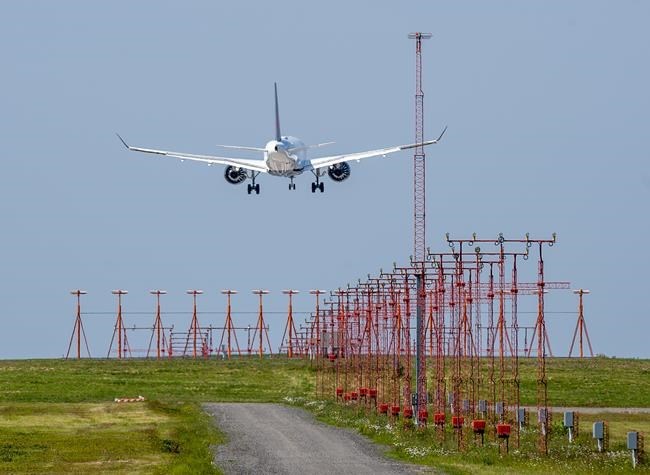MONTREAL — Air Canada reported that first-quarter revenue nearly doubled compared with a year earlier as travellers hopped back on airplanes en masse — even as higher costs tamped down net earnings.
Buoyed by a record $4.9 billion in revenue, the quarter marked the second in a row where the carrier has turned a profit following 11 straight quarters of losses totalling $10.1 billion.
Net income amounted to $4 million, in stark contrast to $974 million in losses a year ago.
Chief executive Michael Rousseau said the results for the three months ended March 31 beat out all expectations for a traditionally weaker quarter, and that he believes demand will persist amid strong advance bookings for the rest of the year. They hit $5.3 billion at the end of March, up from $4.1 billion a year earlier.
"The winter and the start of the spring can be very challenging in North America, especially Canada. Apart from the weather disruptions that can affect all aspects of the air transport system, it usually comes with high traffic flows, particularly with a spring break peak," Rousseau told analysts on a conference call Friday.
Despite an uncertain economic outlook — and the carrier's on-time arrival rate of 57 per cent in March versus 70 per cent in March 2019 — Air Canada's sustained profits over the past half-year hint at a return to stability for an industry devastated by the COVID-19 pandemic, when lockdowns, border closures and travel restrictions tanked demand.
The airline's load factor — the percentage of seats filled — jumped to 85 per cent last quarter from two-thirds the year before.
Air Canada Vacations, the carrier's tour package business, yielded "remarkable results," the CEO said.
Its shipping business added five more cargo planes to the sole Boeing 767 freighter it operated a year ago, though cargo revenues dropped 40 per cent year over year. Only four of those freighters were in use, while other planes that had temporarily converted to cargo shipping reverted to passenger trips as China reopened and e-commerce and consumer demand scaled back.
Chief financial officer Amos Kazzaz, slated to step down on June 30, noted that "the cost world is different" than before 2020, with everything from airplane food to ground handlers toting a higher price tag.
Air Canada's $4-million profit was a far cry from its first-quarter net earnings of $345 million in 2019, the last full year untouched by COVID-19. That owes partly to a 30 per cent increase in the cost of jet fuel over the past year as well as greater maintenance and labour expenses.
Meanwhile, thanks to higher rates, the interest expense on Air Canada's $6.5-billion net debt rose 17 per cent to $245 million year over year, even though the carrier had reduced that debt by a half-billion dollars.
But that leverage is dropping faster than anticipated, analysts say, with the airline's net debt ratio sitting at 3.2 times at the end of the quarter compared to 5.1 times at the end of 2022.
Lower-than-expected current jet fuel prices prompted Air Canada last week to raise its financial forecast for the year. The Montreal-based company boosted its adjusted earnings expectations to between $3.5 billion and $4 billion from $2.5 billion to $3 billion.
Pricier tickets are helping too. Passenger yield — the average amount received per customer flown one mile — climbed nine per cent year over year, despite feisty competition from budget carriers for sun destinations and some domestic routes.
"There is likely ongoing yield pressure from new ultra-low-cost entrants. However, these new competitive pressures have been more than offset by a robust international environment and significant ground package revenues at Air Canada Vacations, which outperformed our expectations," said TD Cowen analyst Helane Becker in a note to investors.
Business travellers are also finally starting to return — and they're willing to pay. About 30 per cent of year-over-year revenue growth last quarter came from "premium cabins," said Mark Galardo, Air Canada's head of revenue and network planning.
"The strong and improving collaboration between our people and our ecosystem partners has been key to our service delivery during this period, and sets our expectation for continued strong performance through the summer," Rousseau added.
Perhaps not strong enough. On Thursday the National Airlines Council, which represents Air Canada and three other large airlines, called on Ottawa to impose a system of "shared accountability" on the aviation sector. It hopes to see industry players — from security screeners to border guards and air traffic controllers — shoulder responsibility when due for flight delays and cancellations that result in passenger compensation and communicate reasons for those disruptions.
Friday's reported revenue for the quarter was up 90 per cent from the $2.6 billion in the first three months of 2022.
On an adjusted basis, Air Canada said it lost 53 cents per diluted share last quarter compared with an adjusted loss of $2.09 per diluted share a year earlier.
The average analyst estimate predicted an adjusted loss of 74 cents per share and $4.35 billion in revenue, according to financial markets firm Refinitiv.
This report by The Canadian Press was first published May 12, 2023.
Companies in this story: (TSX:AC)
Christopher Reynolds, The Canadian Press



